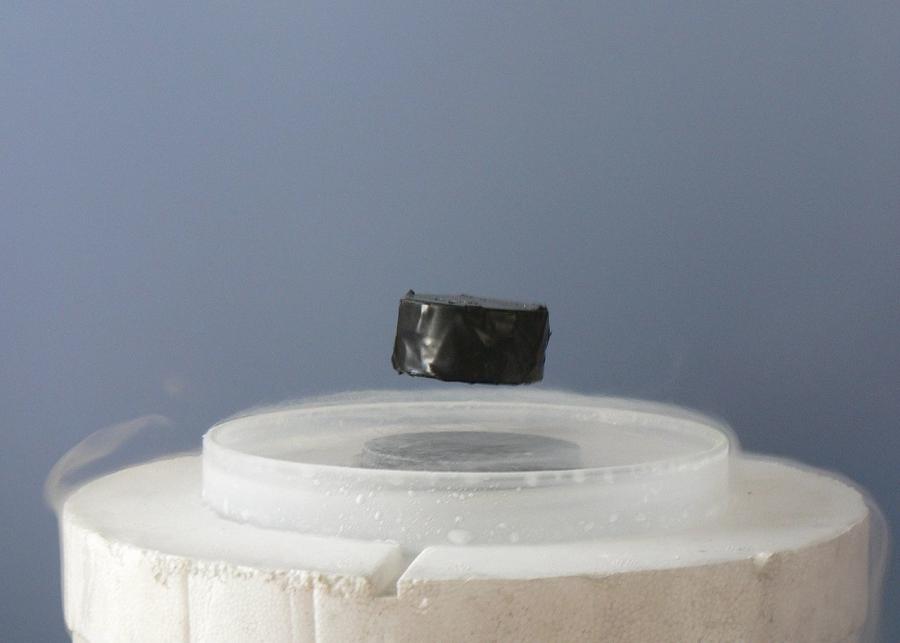Scientists from the Institute for Laser and Plasma Technologies (LaPlas) of the MEPhI are developing energy storage devices of a new type based on the properties of modern high-temperature superconducting materials. Theoretically, in the long term, such storage devices can revolutionize the energy sector. The development was supported by the Priority 2030 program.

Magnet levitation over a liquid nitrogen-cooled superconductor
Bearing levitates
First of all, work is underway on the design of the so-called. kinetic energy storage. It will be a bearing made of modern superconducting composite materials, floating in a gradient magnetic field created by permanent magnets due to the effect of magnetic levitation. Thus, this bearing will not touch the fixed parts of the device, and ideally it should float in a vacuum. Under these conditions, the rotation of the bearing occurs practically without friction. If such a bearing is untwisted (for example, with the help of an electric motor that transmits rotation to the shaft through a connected magnetic coupling), then it will rotate in a void for months, retaining the energy transferred to it almost without loss. If necessary, this energy can be “removed” from it, for example, by reconnecting a magnetic coupling and a generator to the bearing. It is planned that during 2023 a working prototype of the kinetic storage device will be created.
Current flows in a circle
The second type of drive is induction, and it seems even more incredible to the layman. If the winding of a superconducting material is powered by an electric current and then closed to itself, then there will not be a short circuit (as it would be in a conventional electrical circuit), but the electric current will begin to flow in a closed circuit in a circle - and it, too, almost without loss, will keep the current value, and hence the stored energy, for weeks, and maybe months (depending on the degree of optimization of internal losses). Energy from such a storage device can be partially or completely "removed" if necessary and transferred to the payload. In 2023, MEPhI plans to fundamentally develop the design of an induction storage tank "on paper" and calculate its technical characteristics.
Energy in the cold
The main advantage of the new type of storage devices is their capacity: in terms of energy density to mass, storage devices based on superconductors should be many times greater than conventional batteries. Also important is the possibility of partial removal of energy and their recharging during operation.
However, their important technical feature is that the composites used in the structures exhibit their superconducting properties only at very low temperatures. Although the superconductors that are supposed to be used in the development of MEPhI are called "high-temperature", these temperatures can only be called high by the standards of the world of superconductors. These drives can work only if the temperature inside them is maintained no higher than 77 degrees on the Kelvin scale - that is, a little more than minus two hundred degrees Celsius. This corresponds to the boiling point of liquid nitrogen, and it is with the help of it that they are going to maintain a low temperature inside the drive. Igor Rudnev, a professor at the LaPlas Institute and a leading researcher at the Superconducting Energy Systems laboratory, explained that liquid nitrogen is quite cheap, and modern thermal insulation systems will make it possible to add nitrogen to storage tanks no more than once a month.
From windmills to electric buses
Of course, the question of the economy of such storage devices remains acute. The composite high-temperature superconductors and rare earth magnets used in them are quite expensive. According to Igor Rudnev, these drives can be used in "green" energy and industry. For example, they can be used to increase the uniformity of energy generation at solar and wind power plants: when there is wind or sun, the storage device will be recharged, but when natural factors fail, the storage device starts to supply energy to the grid. Also, they can be used as a backup power source in industrial plants, where the continuity of production is of great importance. It is not excluded the use of such drives on large electric transport (like electric buses).
Energy on superconductors
In the long term, MEPhI plans to create prototypes of not only storage devices, but devices for all phases of generation, production, transmission and storage of electricity using superconductors: add a generator (wind or solar) based on superconductors to the storage device, and a superconducting cable. Thus, it will be possible to see a prototype of the electric power industry of the future, which will be the Superconducting Energy Cluster of MEPhI.





